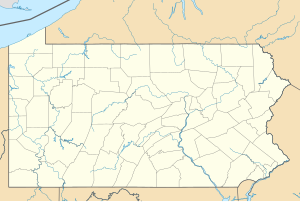Sonestown Covered Bridge
| Sonestown Covered Bridge | |
| Davidson Covered Bridge | |
| National Register of Historic Places | |
|
The Sonestown Covered Bridge over Muncy Creek (west portal and north side)
|
|
| Official name: Sonestown Covered Bridge | |
| Named for: Village of Sonestown | |
| Country | United States |
|---|---|
| State | Pennsylvania |
| County | Sullivan |
| Township | Davidson |
| Road | TR 310 (single lane) |
| Crosses | Muncy Creek |
| Elevation | 933 ft (284 m) |
| Coordinates | 41°20′47″N 76°33′18″W / 41.34639°N 76.55500°WCoordinates: 41°20′47″N 76°33′18″W / 41.34639°N 76.55500°W |
| Length | 110 ft (34 m) |
| Width | 15.0 ft (4.6 m) |
| Clearance | 10.0 ft (3.0 m) |
| Design | Burr Arch Truss Bridge |
| Material | Wood |
| Built | c. 1850 |
| - Repaired / restored | 1969, 1996, 2001, 2005, 2013 |
| Owned and Maintained by | Sullivan County |
| NBI Number | 000000000032095 |
| WGCB Number | 38-57-03 |
| Load | 3 tons (2.7 t) |
| Added to NRHP | July 24, 1980 |
| NRHP Ref# | 80003640 |
| MPS | Covered Bridges of Bradford, Sullivan and Lycoming Counties TR |
The Sonestown Covered Bridge is a Burr arch truss covered bridge over Muncy Creek in Davidson Township, Sullivan County, in the U.S. state of Pennsylvania. Built c. 1850, the bridge is 110 feet (34 m) long, and was placed on the National Register of Historic Places (NRHP) in 1980. The bridge is named for the nearby unincorporated village of Sonestown in Davidson Township, and is also known as the Davidson Covered Bridge. It was built to provide access to a gristmill, which operated until the early 20th century.
Pennsylvania had the first covered bridge in the United States and the most such bridges in the 19th, 20th, and 21st centuries. In most places in the state they were a transition between stone and metal bridges, with the roof and sides protecting the wooden structure from weather. The Sonestown bridge is a Burr arch truss type, with a load-bearing arch sandwiching multiple vertical king posts, for strength and rigidity. The bridge construction is cruder than the other two surviving covered bridges in Sullivan County, with each Burr arch formed from six straight beams set at angles instead of a smooth curve.
The bridge was repaired c. 1969, and after flood damage in 1996, 2005, and 2013. It was also restored in 2001. Despite the repairs and restoration, as of 2012 the bridge structure's sufficiency rating on the National Bridge Inventory was only 19.0 percent and its condition was deemed "Structurally deficient" (the bridge was also closed in 2012, awaiting repair). It is the shortest covered bridge in the county and as of 2015 is still in use, with average daily traffic of 50 vehicles in 2010.
...
Wikipedia


